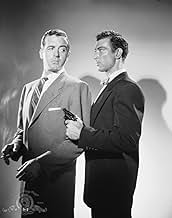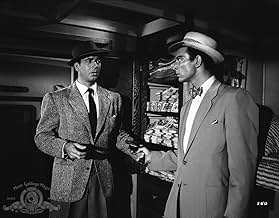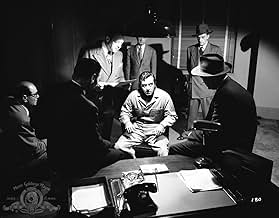IMDb RATING
7.3/10
8.8K
YOUR RATING
An ex-con trying to go straight is framed for a million dollar armored car robbery and must go to Mexico in order to unmask the real culprits.An ex-con trying to go straight is framed for a million dollar armored car robbery and must go to Mexico in order to unmask the real culprits.An ex-con trying to go straight is framed for a million dollar armored car robbery and must go to Mexico in order to unmask the real culprits.
Orlando Beltran
- Porter
- (uncredited)
Ray Bennett
- Prisoner
- (uncredited)
Chet Brandenburg
- Robbery Spectator
- (uncredited)
Barry Brooks
- Player
- (uncredited)
Charles Cane
- Detective Barney
- (uncredited)
Edward Coch
- Airline Clerk
- (uncredited)
Featured reviews
Driving a truckful of posies for a florist seems about as safe an occupation an ex-con could hope for. But for John Payne in Phil Karlson's Kansas City Confidential, it gets him framed for a million-two robbery. His trouble is that you can set a clock by his punctual rounds, and that one of his deliveries coincides with the arrival of the armored car at the bank next door. His comings and goings have been meticulously stop-watched by the mastermind of the heist (Preston Foster), a disgruntled policeman forced into retirement who seeks his weird sort of revenge.
Foster's plan assembles a gang who wear masks during the plotting so they can't recognize one another, or him. Payne's just the innocent fall guy who's thrown to the cops. Those cops try to beat a confession out of him, but it won't stick. He nonetheless loses his job and ends up on the front pages as the prime suspect. So he goes on the earie and follows the robbers (Jack Elam, Lee Van Cleef and Neville Brand) down to Mexico, where they're to meet with `Mr. Big' again and divvy up the take.
The spanner in the works proves to be Foster's daughter (Coleen Gray), striking sparks with Payne as he poses as one of the conspirators killed in Tijuana en route to the rendezvous. Gray's an aspiring lawyer in ignorance of daddy's scheme which is to turn over the robbers, thus rehabilitating himself with the force, and to collect the insurers' reward of $300-large.
Those south-of-the-border resort bungalows, during the noir cycle at any rate, were hotbeds of passion and gunplay. Karlson gives us a little of the former (not his long suit) but plenty of the latter. Over cardgames in the lobby and chance meetings amid the subtropical foliage at night, the unknown players try to sniff one another out and gain whatever edge they can. Their final gathering, aboard a boat called the Manana, shakes out as a crashing intersection of cross-purposes.
Like Dick Powell, Payne started off as a crooner and hoofer, a light leading man (his best remembered role is as Maureen O'Hara's fiancé in Miracle on 34th Street). But in three films under Phil Karlson's direction (plus Robert Florey's in The Crooked Way and Allan Dwan's in Slightly Scarlet), he ended up one of the most convincing ordinary-guy protagonists in the noir cycle. He's tough, all right, but still shows the flop-sweat of fear; and he's smart, too, but because he's forced to be what he's trying to hang onto is all he's got.
Off-screen, he was even smarter, seeing the potential revenue in color films (like Hell's Island and Slightly Scarlet) when selling to television was at most a pipe dream. But as an actor in the ambiguous world of film noir, he's seldom given the credit he deserves. He's every bit as good as Powell or Glenn Ford, if not quite so emblematic as Humphrey Bogart or Robert Mitchum or Burt Lancaster. Karlson's brutal, accomplished works late in the noir cycle gave Payne his place in the dark sun.
Foster's plan assembles a gang who wear masks during the plotting so they can't recognize one another, or him. Payne's just the innocent fall guy who's thrown to the cops. Those cops try to beat a confession out of him, but it won't stick. He nonetheless loses his job and ends up on the front pages as the prime suspect. So he goes on the earie and follows the robbers (Jack Elam, Lee Van Cleef and Neville Brand) down to Mexico, where they're to meet with `Mr. Big' again and divvy up the take.
The spanner in the works proves to be Foster's daughter (Coleen Gray), striking sparks with Payne as he poses as one of the conspirators killed in Tijuana en route to the rendezvous. Gray's an aspiring lawyer in ignorance of daddy's scheme which is to turn over the robbers, thus rehabilitating himself with the force, and to collect the insurers' reward of $300-large.
Those south-of-the-border resort bungalows, during the noir cycle at any rate, were hotbeds of passion and gunplay. Karlson gives us a little of the former (not his long suit) but plenty of the latter. Over cardgames in the lobby and chance meetings amid the subtropical foliage at night, the unknown players try to sniff one another out and gain whatever edge they can. Their final gathering, aboard a boat called the Manana, shakes out as a crashing intersection of cross-purposes.
Like Dick Powell, Payne started off as a crooner and hoofer, a light leading man (his best remembered role is as Maureen O'Hara's fiancé in Miracle on 34th Street). But in three films under Phil Karlson's direction (plus Robert Florey's in The Crooked Way and Allan Dwan's in Slightly Scarlet), he ended up one of the most convincing ordinary-guy protagonists in the noir cycle. He's tough, all right, but still shows the flop-sweat of fear; and he's smart, too, but because he's forced to be what he's trying to hang onto is all he's got.
Off-screen, he was even smarter, seeing the potential revenue in color films (like Hell's Island and Slightly Scarlet) when selling to television was at most a pipe dream. But as an actor in the ambiguous world of film noir, he's seldom given the credit he deserves. He's every bit as good as Powell or Glenn Ford, if not quite so emblematic as Humphrey Bogart or Robert Mitchum or Burt Lancaster. Karlson's brutal, accomplished works late in the noir cycle gave Payne his place in the dark sun.
This is an exceptional Film Noir movie that almost merits a score of 9--it's THAT good. Like good Noir, it features some of the ugliest and scariest actors and I applaud the producers for finding such a motley group! Jack Elam, Lee Van Cleef and Neville Brand are definitely the ugliest and toughest looking heavies of the age and here they all work together on a heist. The movie also stars John Payne and Preston Foster. While these two guys weren't as hideous as the other three, they were both well past their handsome prime--hence they were great Noir characters! In addition, the film is bloody and violent--definite pluses for Noir. While this may sound like Noir films are super-violent, they were compared to the average picture of the day but pale in comparison to more recent films. I like them because they are so gritty and realistic in their blunt portrayal of crime. In this case, watching John Payne slap the snot out of Van Cleef is an amazing scene. As for the plot, it's amazingly complex and interesting. So good, in fact, that I don't want to talk about the heist--lest if ruin the suspense. Suffice to say, it's well worth seeing with great writing, acting and all the elements you are looking for in Noir. A must-see for lovers of the genre.
What a burst of casting inspiration-- three premier baddies, Elam, Brand, and Van Cleef all together in the same film, menacing the heck out of a vengeful John Payne. Elam should have gotten extra pay since everybody and his brother knocks the skinny wild-eyed guy around. Actually, for awhile I thought the movie was one long cigarette commercial or at least a chain-smokers' revival meeting. Speaking of casting, Preston Foster really delivers in a sly role that runs the gamut from tough-talking mastermind to nice-guy fisherman, all in convincing fashion.
"Kansas City" is, I believe, the first and clearly the best of a number of "Confidential" films made during the mid-fifties. For example, note the unusually brutal cop interrogation of fall-guy Payne. Keep in mind, this was during a Cold War time when the TV mega-hit "Dragnet" was professionalizing law enforcement's image nation-wide. Here, however, we get quite a different picture that certainly goes beyond the norm of the day. In fact, director Karlson, like noir filmmaker Anthony Mann, built a reputation for emphasizing the raw nature of thuggish violence, at least as much as the censors would allow. And this is certainly one of the more graphically brutal films of the era.
All in all, it's a fine imaginative script, with a number of unconventional surprises. The robbery is cleverly plotted along with the get-away. I like the way the screenplay parcels out needed information instead of laying it all out at the beginning. That way, viewer interest is kept up since a new wrinkle might pop up at any moment. Even pretty girl Colleen Gray's part is nicely woven in at the end, after I thought she was just a romantic interest. I guess Dona Drake's role was a touch of local color or a favor to somebody since she adds nothing to the plot, but apparently her Mexican girl does sell more than just souvenirs.
There are echoes from this movie in such later caper films as The Killing, Plunder Road, and Mark Steven's underrated Timetable. Some might consider this a noir film since Payne is trapped by unseen forces through no fault of his own. Nonetheless, other traditional noir elements are noticeably absent, such as the angular shadows of expressionist lighting and the lack of a customary spider woman. But it doesn't really matter how the movie's categorized because it remains something of a sleeper with a number of genuine surprises.
"Kansas City" is, I believe, the first and clearly the best of a number of "Confidential" films made during the mid-fifties. For example, note the unusually brutal cop interrogation of fall-guy Payne. Keep in mind, this was during a Cold War time when the TV mega-hit "Dragnet" was professionalizing law enforcement's image nation-wide. Here, however, we get quite a different picture that certainly goes beyond the norm of the day. In fact, director Karlson, like noir filmmaker Anthony Mann, built a reputation for emphasizing the raw nature of thuggish violence, at least as much as the censors would allow. And this is certainly one of the more graphically brutal films of the era.
All in all, it's a fine imaginative script, with a number of unconventional surprises. The robbery is cleverly plotted along with the get-away. I like the way the screenplay parcels out needed information instead of laying it all out at the beginning. That way, viewer interest is kept up since a new wrinkle might pop up at any moment. Even pretty girl Colleen Gray's part is nicely woven in at the end, after I thought she was just a romantic interest. I guess Dona Drake's role was a touch of local color or a favor to somebody since she adds nothing to the plot, but apparently her Mexican girl does sell more than just souvenirs.
There are echoes from this movie in such later caper films as The Killing, Plunder Road, and Mark Steven's underrated Timetable. Some might consider this a noir film since Payne is trapped by unseen forces through no fault of his own. Nonetheless, other traditional noir elements are noticeably absent, such as the angular shadows of expressionist lighting and the lack of a customary spider woman. But it doesn't really matter how the movie's categorized because it remains something of a sleeper with a number of genuine surprises.
This is a nifty film noir that is a must for fans of the genre. It isn't as well known as other films by Phil Karlson, such as THE PHENIX CITY STORY or WALKING TALL, but for my money it's better than either of them. It predates PHENIX with that film's expose look, as KANSAS CITY CONFIDENTIAL's climax is shot in a gritty, docudrama style. Only the sappy resolution in the conclusion disappoints (which was likely studio-imposed, just to temper the hard-edge of the film; see also FOLLOW ME QUIETLY). Nonetheless, it is a tightly-written noir with great mood and atmosphere. Another plus is the generous showcases given to classic bad guys Lee Van Cleef, Neville Brand and Jack Elam, all so early in their careers.
John Payne stars in "Kansas City Confidential," a 1952 noir also starring Preston Foster, Colleen Gray, Jack Elam, Neville Brand and Lee Van Cleef. Payne is Joe Rolfe, a WW II vet who delivers flowers for a living. He finds himself accused of a spectacular robbery of $1.2 million because the thieves used a truck like his as their escape vehicle. With the help of a buddy, he finds out that a criminal has split town suddenly for Mexico, and he goes there to locate the man and hopefully clear his own name. What he doesn't realize is that there were four thieves, and all of them wore masks to shield their identities from one another. When the man he's tracking is killed, Joe assumes his identity and goes to the place where the other thieves are supposed to await further instructions from their boss.
Phil Karlson directed this good noir, which has an excellent cast that includes a favorite actress of mine, the lovely Coleen Gray as an ex-cop's daughter. She shows up at the locale to surprise her dad (Preston Foster), who is actually the mastermind of the heist.
Like any actor who worked for 20th Century Fox, John Payne had to be versatile, and he was. Here he plays a rough-around-the-edges war hero who has to survive among thieves by being tougher than they are. The the man known as "The Singing Tyrone Power" at Fox pulls it off. A handsome leading man, here Payne steps into John Garfield territory with ease. Elam, van Cleef and Brand are as mean and low-down as you can get, and the film gets quite violent at times.
The print I saw was very grainy; this wasn't a studio B movie but one made on the cheap, though the film was distributed by UA. However, it stands up very well next to other noirs of that era.
Phil Karlson directed this good noir, which has an excellent cast that includes a favorite actress of mine, the lovely Coleen Gray as an ex-cop's daughter. She shows up at the locale to surprise her dad (Preston Foster), who is actually the mastermind of the heist.
Like any actor who worked for 20th Century Fox, John Payne had to be versatile, and he was. Here he plays a rough-around-the-edges war hero who has to survive among thieves by being tougher than they are. The the man known as "The Singing Tyrone Power" at Fox pulls it off. A handsome leading man, here Payne steps into John Garfield territory with ease. Elam, van Cleef and Brand are as mean and low-down as you can get, and the film gets quite violent at times.
The print I saw was very grainy; this wasn't a studio B movie but one made on the cheap, though the film was distributed by UA. However, it stands up very well next to other noirs of that era.
Did you know
- TriviaJohn Payne broke some of Jack Elam's ribs in a fight scene.
- GoofsWhen approaching the bank for the heist, a mountain is clearly seen in the background. Kansas City is in the plains and has no mountains.
- Quotes
Scott Andrews: [Speaking about Rolfe] ... left school to enlist with the engineers. Pretty good soldier too! Bronze Star, Purple Heart!
Joe Rolfe: Try and buy a cup of coffee with them!
- Crazy creditsOpening credits prologue: "In the police annals of Kansas City are written lurid chapters concerning the exploits of criminals apprehended and brought to punishment."
"But it is the purpose of this picture to expose the amazing operations of a man who conceived and executed a 'perfect crime,' the true solution of which is NOT entered in ANY case history, and could well be entitled 'Kansas City Confidential.'"
- ConnectionsEdited into Tep No & KT Tunstall: Heartbeat Bangs (2021)
- SoundtracksLa Cucaracha
(uncredited)
Spanish Traditional
Sung by Tomaso as he delivers the mail
- How long is Kansas City Confidential?Powered by Alexa
Details
- Release date
- Country of origin
- Languages
- Also known as
- The Secret Four
- Filming locations
- Two Harbors, Santa Catalina Island, Channel Islands, California, USA(scenes in "Borados")
- Production companies
- See more company credits at IMDbPro
- Runtime1 hour 39 minutes
- Color
- Aspect ratio
- 1.37 : 1
Contribute to this page
Suggest an edit or add missing content



































